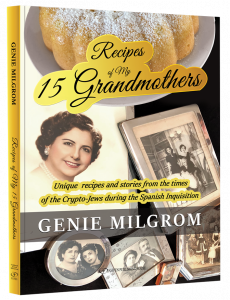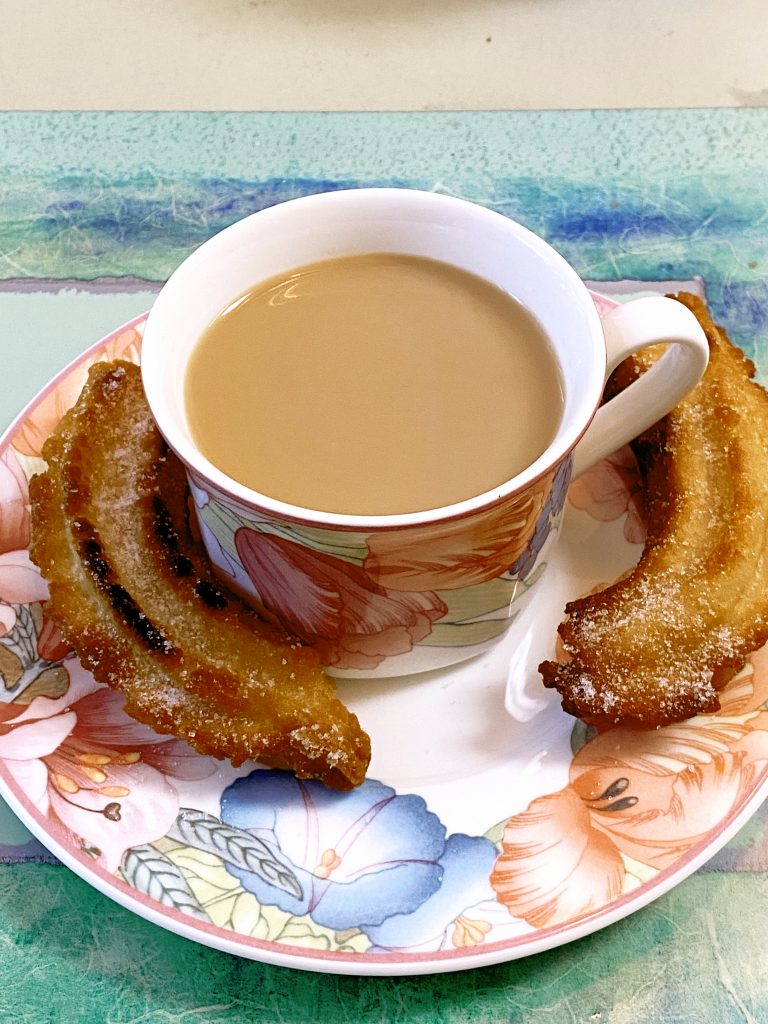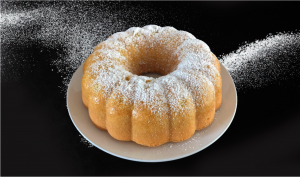Finding a stash of old recipes, Genie Milgrom discovered the truth about her family’s Jewish identity, hidden for generations.
And the end of all our exploring
Will be to arrive where we started
And know the place or the first time.
—T.S. Eliot, Four Quartets
These poetic verses perfectly characterize the journey of Genie Milgrom, author of a new cookbook entitled Recipes of My Fifteen Grandmothers: Unique Recipes and Stories from the Times of the Crypto-Jews during the Spanish Inquisition.

Comprised of recipes from family lore, this unique cookbook reflects the flavors of Spanish and Sephardic cooking.
Born in Havana and raised in Miami, Genie never felt in sync with her family’s upper-crust Catholic, Spanish-Cuban milieu. Her grandparents had emigrated from Spain to Cuba in 1917, where her mother’s family manufactured silk stockings and her father’s family sold pharmaceuticals. Extremely successful, they were able to flee to Miami nine months after Castro came to power in 1959, when Genie was four.hese poetic verses perfectly characterize the journey of Genie Milgrom, author of a new cookbook entitled Recipes of My Fifteen Grandmothers: Unique Recipes and Stories from the Times of the Crypto-Jews during the Spanish Inquisition.
She was educated in top Catholic schools and universities, where, frustrated by her teachers’ inability to answer her questions satisfactorily, she was regarded as a gadfly. After befriending a Jewish girl in day camp, Genie developed a fascination with Judaism that grew as she learned more about it during college, where she devoured Jewish books. In her thirties, divorced with two children, she could no longer ignore the prompting of her soul, and undertook a process of conversion that lasted more than five years.
It was a long, lonely road. “When I left Catholicism, I lost my Catholic friends,” Genie says. “I started with Reform, but when I left that and moved to a Conservative synagogue, I lost my Reform friends. Then, when I moved to Young Israel, I lost my Conservative friends!” But it was at a shtiebel that she finally found her comfort zone.
She didn’t stay in the wings for long. A successful businesswoman who is by nature a mover and shaker, Genie exudes warmth and enthusiasm. She became a vital member of the shul, eventually serving as treasurer and president of the sisterhood.
A few years after her conversion, Genie remarried. Her new husband, who has Chassidic roots, had attended Mesivta Tifereth Jerusalem under Rabbi Moshe Feinstein, zt”l, and subsequently, Telshe Yeshiva. His mother, children and numerous grandchildren lived in Israel, and Genie was thrilled by her first encounter with the Holy Land and her new family.
When Genie’s grandmother died on a Friday morning, her mother insisted—based on some nebulous “family tradition”—that the burial had to take place right away, within eighteen hours, which is highly unusual for Catholics. Despite Genie’s protests, her parents made the funeral on Shabbat, and she was unable to attend. When she came to her parents’ house soon after the funeral, her mother handed her a small box her grandmother had insisted she receive.
Inside, to Genie’s surprise, was a pair of old earrings with a Magen David and a pendant with a hamsa. Genie had an epiphany: “My ancestors must have been Jewish!”
She asked her mother for family records, but her mother insisted none existed. At last, her mother yielded and brought out some old boxes of papers, which contained no hints of Judaism. But at the very bottom, Genie found a family tree drawn up by her grandfather twenty years prior, going back to the 1800s. Finally, a lead!
Spanish census reports, available online, brought her a couple of generations further back. She began researching Fermoselle, the village of her grandparents, located on the border between Spain and Portugal, and discovered that two of the family names, Ramos and Garrido, were originally Jewish. She located a genealogist heading to the region and paid him to search for records. Church records brought her as far back as 1545, but then stopped. Even Inquisition records led to a dead end.
When Genie and her husband met Rabbi Nissim Karelitz in Meah Shearim, he told her husband, “You don’t have to turn salt into salt. Your wife is Jewish!” But the beit din in Jerusalem told her she needed to trace back even further to prove Jewish lineage. She had to find a Jewish woman at the top of her family tree.
Genie and her husband finally went to Fermoselle themselves. Although the locals were initially evasive when she asked about signs of a Jewish presence, it was a deeply moving trip. Little by little, she discovered that the town had been Jewish prior to the Inquisition; she learned of the existence of an underground synagogue and mikveh, writings on walls in Hebrew letters, subterranean tunnels connecting the houses. (She would later produce a short documentary about the town’s Jewish heritage.) Genie was even more shaken by a feeling of soul recognition she experienced while in the town; she came upon a street she had seen numerous times in her dreams.
The village of Fermoselle is situated on the banks of a river separating Spain from Portugal. It finally occurred to Genie that she had probably lost her family’s trail because they hadn’t remained in Spain! Like so many others, they had fled to Portugal when the Inquisition began. She turned to the National Archives of Torre de Tombo, the Portuguese national archive, for records and family trees from the Portuguese Inquisitions that had been digitized. Now she hit pay dirt. Here was the rest of her family tree, confirming what she’d always felt in her bones: She had really been Jewish to begin with!
Inside, to Genie’s surprise, was a pair of old earrings with a Magen David and a pendant with a hamsa. Genie had an epiphany: “My ancestors must have been Jewish!”
The records showed that her maternal grandmothers in the sixteenth and seventeenth generations were Jewish. “I finally succeeded in going back twenty-two generations,” she said in a National Public Radio interview. Genie managed to trace her Jewish roots back to the year 1405 on her mother’s side and to 1110 on her father’s side. But the Inquisition records in Lisbon told horrifying stories. Forty-five members of her family had been burned at the stake, including a fifteen-year-old girl named Michaela. She discovered she was related to Luis de Carvajal, the governor of a Spanish province in present-day Mexico who was persecuted along with his family by the Inquisition (his grandmother was Genie’s fourteenth great-grandmother).
The family tree revealed her family’s determination to keep the Jewish line pure. “It’s what genealogists call a ‘collapsed’ family tree,” Genie explains. “Within the family, people married among themselves, cousins to cousins.” She noticed that the babies had rarely been baptized or were supposedly baptized by the midwife; the records often noted, “child is deathly ill,” even though later records suggested the child had been perfectly healthy. Recorded dowry agreements read suspiciously like tena’im (terms of a Jewish marriage).
Genie eventually wrote a book, My Fifteen Grandmothers (Jerusalem, 2012), about her search for her Jewish roots. Her journey rendered her a beacon for people who suspect they have Jewish lineage and wish to trace their family backgrounds. She now receives hundreds of e-mails, mostly from South America but also from the Philippines, Portugal, and even Hawaii and Iceland. With the help of an Israeli company, she is working on digitizing all of her family records from Spain from the time of the Inquisition, so that others can search their roots without having to travel or hire a genealogist as she did.
The Crypto Kitchen
There had always been hints of Judaism in her family’s kitchen practices, if you knew where to look for them. “My maternal grandmother, who taught me to cook, always checked eggs for blood spots, and would wash and check vegetables and rice for bugs,” Genie says. “When she baked in quantity, she’d take a small piece of dough and throw it into the back of the oven—‘para buena suerte (for good luck),’ she’d say.” These practices were attributed to “family tradition.”
Genie’s mother, as if held back by an ancient, residual fear of being discovered, had always resisted Genie’s efforts to probe into their family background. But when her mother became ill and had to leave her home to an assisted living residence, Genie discovered a suitcase containing family trees, birth and death certificates, and baby books—“originals of all the documents I’d spent ten years trying to find!” In addition, she found scraps of paper and old books filled with pages of recipes handwritten in tiny letters, left by generations of the family’s women.
The value of this cookbook is as much historical and family document as it is modern cookbook.
Over the years, the recipe ingredients sometimes changed, reflecting the family’s migrations. Not every recipe was strictly kosher. But never did any recipe combine meat and milk, and there were many that replaced flour with potato starch, as if to make them kosher for Passover. Quite a few recipes suggested Jewish holidays, such as orejuelas, or “ears” for Purim (like today’s Israeli aznei Haman). A recipe for chuletas, pork chops, was actually a recipe for a sort of French toast designed to look like a pork chop. “The Crypto-Jews would eat them while burning a piece of pork in the fireplace to make the neighbors think they were eating treif,” Genie explains.
Genie took this trove of domestic family lore and began entering it into her computer. She recruited friends to help her test out all the recipes. Many had to be modified; for example, eggs today are substantially larger than eggs a hundred years ago, so many recipes they tested came out too “eggy.” Some tasted too strongly of olive oil, which, in a region famous for its olives and olive oil, was used even in recipes for desserts and cookies.
When everyone had finished testing the recipes, Genie invited all her testers for a potluck Shabbat meal to sample them. It was “a rich and fun night of sharing,” Genie says. Recipes of My 15 Grandmothers was born from these efforts.
The cookbook reflects the flavors of Spanish and Sephardic cooking, using ingredients like peppers, tomatoes, almonds and anise. At Genie’s suggestion, I tried making the garbanzo empanadas, which were eagerly devoured by my family, and the anise torticas, a biscuit similar to Syrian sweet ka’ak. As is often typical of informal family recipes, there are no estimates for time of preparation (although Genie classifies them as “easy” to “difficult” in her book), and often no “yields.” But the value of this cookbook is as much historical and family document as it is modern cookbook.
Never one to rest on her laurels, Genie is now finishing up a sequel entitled Salsa! It represents her efforts, over the past thirty-odd years, to create kosher versions of the Cuban and Caribbean recipes she grew up with.
But it is her grandmother’s Spanish recipes that influenced her most strongly, and she treasures her memories of preparing foods like periquillos (a fried dough recipe from Fermoselle) with her. Jewish food, it seems clear, is absorbed not only in our stomachs but in our souls. You can suppress Jews from practicing their religion, but as Recipes of My Fifteen Grandmothers suggests, our recipes continue to transmit our heritage long after formal observance has disappeared.
* * *
Recipes adapted from Genie’s Milgrom’s Recipes of My 15 Grandmothers.
Periquillos (Parrot Beaks)
Yields about 40 small periquillos
Different than the usual Chanukah fare, these fried “balls” are perfect for the holiday!
6 large eggs
3 ½ cups sugar
¾ cup olive oil
6 tablespoons anise liqueur
2 one-ounce bottles anise essence
5 ½ cups flour, plus up to one cup more
Oil for frying
1. Mix the eggs with the sugar until the sugar is dissolved. (Genie mixes this by hand.) Add the oil, liqueur and anise essence and mix well.
2. Add the 5 ½ cups of flour slowly, and mix until you can start molding small balls with your hands. Add only enough flour to make small balls, about 1 to 1 ½ inches, the size of a ping-pong ball or a bit smaller. Keep your hands well-oiled to make it easier to form the balls. If more flour than necessary is used, the balls will be too hard.
3. Heat the oil in a saucepan with deep sides, and drop the balls in one by one. Deep fry until they are golden brown and a small “beak” opens up. Place on paper towels to drain.
4. To retain their crispiness, periquillos should be stored in tins. If covered with aluminum or plastic, they will become sticky.
Garbanzo Empanadas
1 cup freshly cooked or canned chickpeas
1 cup flour
2 tablespoons margarine
1 teaspoon baking powder
½ teaspoon salt
2 tablespoons olive oil
Seasoned ground beef (½ pound) or ground chicken or a vegetarian option
Oil for frying
Grind the chickpeas finely in a food processor and blend with the flour, margarine, baking powder, salt and olive oil until the dough is soft and pliable. Roll onto a floured surface to about ¼ inch thick, and cut into 2-inch rounds. Place a tablespoon of the meat on the round, cover it with another round, and pinch the edges together like ravioli. Alternatively, you can make larger circles (3 ½ inches or so), place the meat in the center, fold one side over to make a half-moon and seal the edges with the tines of a fork. Fry until golden brown on both sides.
Try this light and fluffy Bundt cake—you won’t regret it!
10 medium eggs
1 cup cornstarch or potato starch
2 teaspoons baking powder
1 cup confectioners’ sugar, plus extra for decoration
Separate the eggs, and in a separate bowl beat the whites until they form stiff peaks. In the bowl with the egg yolks, add the other ingredients and mix well. Fold the egg whites gently into the mixture and place in a greased Bundt pan (according to the grandmothers, it is preferable to use a copper pan, but a Teflon Bundt pan works well too). Bake at 350°F for 30 to 40 minutes, or until a knife inserted in the center comes out clean. Sprinkle with confectioners’ sugar on top.
Churros
Ideal for Chanukah, churros are a fried-dough pastry snack that are traditional in Spain and Portugal. These trendy treats are crispy on the outside and soft and tender on the inside.
3 cups water
1 teaspoon salt
3 cups all-purpose flour
Olive oil for frying
Granulated sugar for dusting the churros
Place water with salt in a saucepan on the fire and bring to a boil; slowly add the flour and stir until combined. Remove from heat and continue mixing by hand until well blended. Form the mixture into long snake-like shapes. Heat the oil in a deep-sided pan and deep fry until golden brown. Drain and dust with sugar.
A long-time Jewish Action contributor, Barbara Bensoussan is the author of a food memoir entitled The Well-Spiced Life, describing her discovery of Sephardic food and faith, and Pride and Preference, a novel re-imagining Austen’s classic in today’s Orthodox world.

